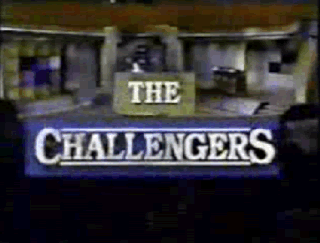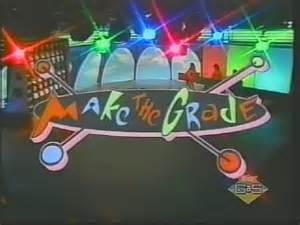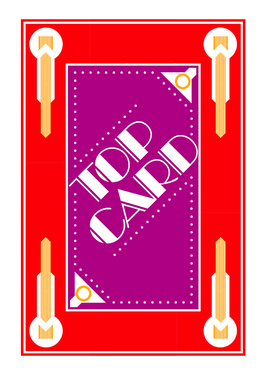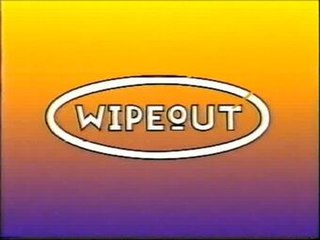
Press Your Luck is an American television game show created by Bill Carruthers and Jan McCormack. Contestants answer trivia questions to earn "spins" on a randomly cycling game board. The board's spaces display cash, prizes, extra spins, special items, or the show's mascot, a cartoon creature known as the Whammy. Landing on a Whammy eliminates any cash and prizes accumulated while also displaying a short comedic animation. Its format is a revival of an earlier Carruthers production, Second Chance, which was hosted by Jim Peck and aired on ABC in 1977. The original version of Press Your Luck aired on CBS between 1983 and 1986. This version featured Peter Tomarken as host, Rod Roddy as announcer, and Carruthers as both director and voice of the Whammy. The original incarnation of the show gained significant media attention in 1984 for contestant Michael Larson, who won over $100,000 after memorizing the original pattern of the game board.

Hot Potato is a television game show that was broadcast on NBC in the United States from January 23 to June 29, 1984. From April 23 until its conclusion, the show was known as Celebrity Hot Potato.
The Joker's Wild is an American television game show that aired at different times between 1972 and 2019. In the show, contestants answer questions based on categories determined randomly by a mechanism resembling a slot machine. The show's title refers to the game's slot-machine mechanism also having jokers.
Monopoly is an American television game show based on the board game of the same name. The format was created by Merv Griffin and produced by his production company, Merv Griffin Enterprises.

The Challengers is an American game show that aired in syndication during the 1990-91 television season The series was created by Ron Greenberg and was based largely on his 1969 production, The Who, What, or Where Game. Dick Clark presided over the show with Don Morrow announcing. The Challengers was a joint production of Ron Greenberg Productions and Dick Clark Productions, with Buena Vista Television as distributor.
Idiot Savants is an American television game show on the MTV network which ran from December 9, 1996, to April 25, 1997. It was created by Michael Dugan and Chris Kreski, directed by Steve Paley, and hosted by comedian Greg Fitzsimmons.

Strike It Lucky is a British television game show that ran from 29 October 1986 to 23 August 1999, originally produced by Thames Television for ITV, and presented by the British comedian Michael Barrymore. It was based on the American game show Strike It Rich that aired in 1986.

Make the Grade is a children's game show that aired from October 2, 1989, to September 14, 1990, on Nickelodeon.

Stump the Schwab is an American game show that aired on ESPN2 and ESPN Classic from July 8, 2004 to September 29, 2006. The show featured three contestants trying to defeat Howie Schwab, ESPN's first statistician, in a sports trivia contest. Stuart Scott was the show's host. The show also appeared on Canada's The Score Television Network.
Time Machine is an American game show where contestants compete to answer trivia questions about popular culture and recent history to win prizes. The show aired on NBC from January 7 through April 26, 1985, and was hosted by John Davidson. Charlie Tuna was the announcer, with Rich Jeffries as his substitute. Reg Grundy Productions produced the series, and upon its premiere Time Machine was one of three Grundy series airing on NBC.

Game Ka Na Ba?, formerly Pilipinas Game Ka Na Ba is a Philippine game show created by ABS-CBN Studios. The main goal of the game is to win 2 million pesos by answering trivia questions.

Tic-Tac-Dough is an American television game show based on the paper-and-pencil game of tic-tac-toe. Contestants answer questions in various categories to put up their respective symbol, X or O, on the board. Three versions were produced: the initial 1956–59 run on NBC, a 1978–86 run initially on CBS and then in syndication, and a syndicated run in 1990. The show was produced by Barry & Enright Productions.

Hit Man is an American television game show. The show aired on NBC from January 3 to April 1, 1983, and was hosted by Peter Tomarken. Rod Roddy was the announcer, and the program was produced by Jay Wolpert Productions in association with Metromedia Video Productions.

Top Card is a game show that aired on TNN and produced by Reid-Land Productions, replacing TNN's original game show Fandango. The show aired from April 3, 1989 to March 26, 1993 and was based on the card game Blackjack.
Fandango is a country music-themed quiz show which aired on The Nashville Network from March 8, 1983 to August 26, 1988, with reruns airing through March 31, 1989, when it was replaced by Top Card. Fandango was the first TV game show to air on TNN and was one of the longest-running game shows on a cable network.
Three on a Match is an American television game show created by Bob Stewart that ran on NBC from August 2, 1971 to June 28, 1974 on its daytime schedule. The host was Bill Cullen and Don Pardo served as announcer on most episodes, with Bob Clayton and NBC staffers Wayne Howell and Roger Tuttle substituting at times.
On the Spot is an American game show produced by and broadcast on KGW-TV in Portland, Oregon as a daily series from September 1984 to October 1988. Newscaster Larry Blackmar was host, while local disc-jockey Michael Bailey announced.
Wipeout was an Australian game show that aired on the Seven Network from 15 February 1999 to 24 November 2000. The show was based on the original American series of the same title and was hosted by Tony Johnston. This version was the only one to use children as contestants, and in turn used points instead of dollars due to a law in Australia and Europe which prohibits children from winning money on game shows. After the show was cancelled, it was rerun until 2004.

Wipeout was a British television quiz show for BBC One, based on the original American programme of the same name. First shown on 25 May 1994, it ran for nine series: the first four of which aired at primetime and were hosted by Paul Daniels; and the last five at daytime and hosted by Bob Monkhouse, with the final episode airing on 17 April 2003, 8 months before Monkhouse died on 29 December 2003.
Takeover Bid is a British game show that aired on BBC1 from 26 May 1990 until 15 July 1991. It was hosted by Bruce Forsyth and assisted by Claire Sutton. The basic premise of Takeover Bid was that of a "reverse game show", where the contestants were given prizes at the beginning of play, and the object of the game was to try and keep them.











